#longitudinal section of flower diagram
Explore tagged Tumblr posts
Video
youtube
ফুলের গর্ভাশয়ের প্রস্থচ্ছেদ পর্যবেক্ষণ ব্যবহারিক চিত্র | How to Draw Longitudinal Section of Flower
ফুলের গর্ভাশয়ের প্রস্থচ্ছেদ পর্যবেক্ষণ ব্যবহারিক (practical) চিত্র অর্থাৎ জবা ফুলের গর্ভাশয়ের প্রস্থচ্ছেদ আঁকা এসএসসি শিক্ষার্থীদের জন্য জরুরী । SSC Students must learn about longitudinal section of flower easy diagram. So they must know how to draw longitudinal section of flower diagram step by step easy method. Lets learn about how to draw longitudinal section of flower class 10 easily or longitudinal section of flower diagram class 10th. You'll learn how to draw cross section of flower.
প্রদত্ত চিত্রটি ফুলের প্রস্থচ্ছেদকে বোঝায় । ফুলে পুরুষ এবং স্ত্রী উভয়ের প্রজনন অংশ থাকে। ফুলের স্ত্রী প্রজনন অংশকে পিস্টিল বা কার্পেল বলা হয়। প্রতিটি কার্পেল স্টিগমা, স্টাইল এবং ডিম্বাশয় দিয়ে তৈরি। ফুলের পুরুষ প্রজনন অংশগুলিকে পুংকেশর বলা হয়। ফুল হল উদ্ভিদের সবচেয়ে আকর্ষণীয় এবং একমাত্র প্রজনন অংশ। এগুলি প্রকৃতির অমূল্য উপহার, যার একটি অনন্য সৌন্��র্য এবং মনোরম সুবাস রয়েছে। ফুলগুলি নতুন বীজ উৎপাদনের জন্য পরাগায়নের মধ্য দিয়ে যায়। সামগ্রিকভাবে, ফুলগুলি একটি সপুষ্পক উদ্ভিদের রূপবিদ্যার একটি প্রধান অংশ গঠন করে।
সমস্ত ভাস্কুলার এবং সপুষ্পক উদ্ভিদ (অ্যাঞ্জিওস্পার্ম) ফুল ধারণ করে এবং রেকর্ড অনুসারে, সপুষ্পক উদ্ভিদগুলি প্রায় ১৪০ মিলিয়ন বছর আগে আবির্ভূত হয়েছিল। সব মিলিয়ে ৪০০,০০০ এরও বেশি প্রজাতির সপুষ্পক উদ্ভিদ রয়েছে, যাদেরকে অ্যাঞ্জিওস্পার্মও বলা হয়।
ফুলের অংশ: ফুলের সবচেয়ে গুরুত্বপূর্ণ অংশগুলির মধ্যে রয়েছে:
পিস্টিল
পাপড়ি
সেপাল
স্ট্যামেন
পাপড়ি এবং সেপালগুলিকে ফুলের উদ্ভিজ্জ অংশ বলা হয়, যেখানে পুংকেশর এবং পিস্টিলকে ফুলের প্রজনন অংশ বলা হয়
ফুলের অনুদৈর্ঘ্য অংশ: এখানে L.S বা ফুলের অনুদৈর্ঘ্য অংশ রয়েছে। উপরের একটি ফুলের অনুদৈর্ঘ্য অংশে, ফুলে পুরুষ এবং স্ত্রী উভয় প্রজনন অংশ থাকে। আসুন ফুলের অনুদৈর্ঘ্য অংশ সম্পর্কে আরও বিস্তারিতভাবে জেনে নিই। ডিম্বাশয়: এটি ফুলের নালীবিহীন প্রজনন গ্রন্থি, যা বীজ গঠনে গুরুত্বপূর্ণ ভূমিকা পালন করে। এই গ্রন্থিটি ডিম বা ডিম্বাণুর সঞ্চয়স্থান হিসেবেও কাজ করে।
শৈলী: এটি পিস্টিলের অভিযোজিত অংশ, যা একটি দীর্ঘ এবং নলের মতো সরু কাণ্ড। এটি স্টিগমা এবং ডিম্বাশয়ের সংযোগ স্থাপন করে কাজ করে, যেখানে ডিম্বাণু নামক স্ত্রী ডিম্বাণু কোষ থাকে।
স্টিগমা: এটি পিস্টিলের অভিযোজিত অংশ, যা ফুলের স্ত্রী প্রজনন অংশের কার্পেলের উপরের অংশে বা গ্রহণযোগ্য ডগায় উপস্থিত থাকে।
পিস্টিল: স্ত্রী প্রজনন অঙ্গের ভেতরের ফুলকে পিস্টিল বলা হয়। এটি মূলত তিনটি অংশ নিয়ে গঠিত - স্টিগমা, স্টাইল এবং ডিম্বাশয়। এই তিনটি অংশই সম্মিলিতভাবে পিস্টিল নামে পরিচিত।
প্যান্টার: এটি একটি হলুদাভ, চার-লম্বিত থলির মতো কাঠামো, যা পরাগরেণু উৎপাদন এবং সংরক্ষণের জন্য দায়ী।
ফিলামেন্ট: একটি সুতোর মতো কাঠামো পৌষ্টিকের সাথে সংযুক্ত থাকে এবং পৌষ্টিককে তার স্থানে সারিবদ্ধ করে কাজ করে।
পুংকেশর: এটি একটি ফুলের পুরুষ প্রজনন অংশ, যা অ্যান্ড্রোসিয়াম নামেও পরিচিত। এতে মূলত একটি পৌংকেশর এবং ফিলামেন্ট থাকে।
পাপড়ি: এটি একটি ফুলের একটি উজ্জ্বল রঙের অংশ, যা পরাগায়নের সময় পরাগায়নকারী এজেন্ট - মৌমাছি, পোকামাকড় এবং পাখিদের আকর্ষণ করে গুরুত্বপূর্ণ ভূমিকা পালন করে। পাপড়ির রঙ সাধারণত উদ্ভিদ থেকে উদ্ভিদে পরিবর্তিত হয়। কিছু উদ্ভিদের গাঢ় বা উজ্জ্বল রঙের পাপড়ি থাকে, আবার কিছু উদ্ভিদের পাপড়ি হালকা বা ফ্যাকাশে রঙের পাপড়ি থাকে।
পুংকেশর: পুষ্পক উদ্ভিদের পরিবর্তিত পাতা। এগুলি পাপড়ির নীচে উপস্থিত সবুজ রঙের অংশ, যা ক্রমবর্ধমান কুঁড়িগুলিকে রক্ষা করে। কিছু ��ুলের পাপড়ি-পুষ্পক থাকে, আবার কিছু ফুলের পাপড়ি-পুষ্পক পৃথক থাকে।
একটি সম্পূর্ণ ফুলে চারটি ঘূর্ণি থাকে: ক্যালিক্স, করোলা, পুংকেশর এবং কার্পেল।
ক্যালিক্স: এটি ফুলের প্রথম এবং বাইরেরতম ঘূর্ণাবর্ত, যার মধ্যে রয়েছে সেপাল নামক একক, ফুলের গোড়ায় অবস্থিত একটি ক্ষুদ্র পাতা। কুঁড়ি পর্যায়ে, ক্যালিক্স সম্পূর্ণ ফুলকে ঘিরে রেখে ফুলকে রক্ষা করে কাজ করে। এটি ফুলের ঘূর্ণাবর্তকে যান্ত্রিক আঘাত এবং শুষ্কতা থেকেও রক্ষা করে।
করোলা: এটি ফুলের দ্বিতীয় ঘূর্ণাবর্ত, যার মধ্যে অনেক সংখ্যক পাপড়ি থাকে। এই পাপড়িগুলি কখনও কখনও সুগন্ধযুক্ত এবং রঙিন, পাতলা এবং নরম হয় যা পরাগায়ন প্রক্রিয়ায় সাহায্য করে পরাগায়নকারী - প্রাণী, পাখি এবং পোকামাকড়কে আকর্ষণ করে। এটি ফুলের প্রজনন অংশগুলিকে রক্ষা করেও কাজ করে।
পুষ্পক: পুষ্পক উদ্ভিদের পরিবর্তিত পাতা। এগুলি পাপড়ির নীচে উপস্থিত ���বুজ রঙের অংশ, যা ক্রমবর্ধমান কুঁড়িগুলিকে রক্ষা করে। কিছু ফুলের পাপড়ি-পুষ্পক থাকে, আবার কিছু ফুলের পাপড়ি-পুষ্পক পৃথক থাকে। পুংকেশরকে ফুলের তৃতীয় ঘূর্ণাবর্তও বলা হয় এবং এটি পুরুষ প্রজনন অংশ। এটি একটি ফিলামেন্ট নিয়ে গঠিত, যা একটি বৃত্তাকার কাঠামো সহ একটি সুতার মতো কাঠামো, উপরে থাকে। পরাগ পরাগপীড়ক দ্বারা উৎপাদিত হয়, যা উদ্ভিদের পুরুষ প্রজনন প্রক্রিয়ায় অবদান রাখে। সমস্ত পুংকেশর উর্বর পীড়ক বহন করে না।
#youtube#ফুলের গর্ভাশয়ের প্রস্থচ্ছেদ পর্যবেক্ষণ#ফুলের গর্ভাশয়ের প্রস্থচ্ছেদ পর্যবেক্ষণ ব্যবহারিক#ফুলের গর্ভাশয়ের প্রস্থচ্ছেদ পর্যবেক্ষণ practical#ফুলের গর্ভাশয়ের প্রস্থচ্ছেদ পর্যবেক্ষণ চিত্র#জবা ফুলের গর্ভাশয়ের প্রস্থচ্ছেদ#longitudinal section of flower easy diagram#how to draw longitudinal section of flower easy#how to draw longitudinal section of flower diagram#longitudinal section of flower diagram#longitudinal section of flower draw#how to draw longitudinal section of flower step by step#longitudinal section of flower drawing easy#how to draw longitudinal section of flower class 10th#how to draw longitudinal section of flower class 10 easily#longitudinal section of flower class 10 diagram#longitudinal section of flower diagram class 10th#longitudinal section of flower class 10th#how to draw longitudinal section of flower class 10#how to draw longitudinal section of flower class 10 easy#longitudinal section of flower easy
1 note
·
View note
Text
Answer : Click on above link....
0 notes
Text
Important Diagrams for Class 10 - Biology
Neuron
Neurons are cells within the nervous system that transmit the information to other nerve cells, muscles, and gland cells. Most neurons have a cell body that contains the nucleus and cytoplasm. Neurons also contain axon and dendrites. The axon extends from the cell body and ends at nerve terminals. Dendrites extend from the cell body and receive messages from neurons. Dendrites are covered with synapses, the contact points where one neuron communicates with another.

Human Brain
Human brain is the central organ of the human nervous system. It receives signals from sensory organs to command and output information to the muscles.
It is composed of three parts:
Forebrain: It consists of the cerebrum, hypothalamus, and thalamus.
Midbrain: It consists of tectum and tegmentum.
Hindbrain: It consists of cerebellum, medulla, and pons.

Reflex arc
It is a neural pathway that controls a reflex. What happens when you touch a hot stove? In situations like these, your reactions are immediate and involuntary. Reflex arc shows the pathway through which the reflex action occurs. The process of reflex action consists of important components such as receptor organs, nerve center, sensory neurons, associate neurons, motor neurons, effector, and spinal cord.

Human Urinary System
The human urinary system consists of the kidneys, renal pelvis, urinary bladder, ureters, and urethra. The purpose of a urinary system is to eliminate waste from the body. Each kidney consists of a functional unit called nephrons which helps filtration of the blood and regulates blood pressure, blood volume, and pH.
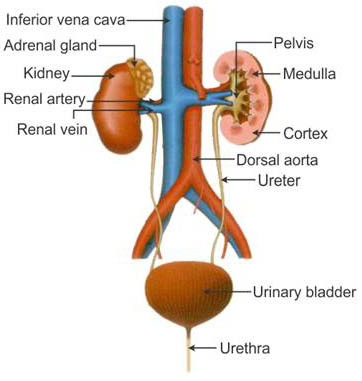
Digestive System
The primary function of the digestive system is to breakdown food into smaller components until it is easily absorbed and assimilated into the body. The digestive system is made up of gastrointestinal tract, liver, pancreas, and gallbladder, stomach, large intestine, and small intestine. These parts of your digestive system help in breaking down food into smaller parts. Once the food is broken down it gets absorbed by the body. The water gets absorbed by the large intestine and the waste product of digestion becomes stool.

Internal Structure of Heart
Human heart is an organ that pumps blood and supplies it throughout the body through blood vessels. It also provides the body with oxygen and nutrients and assists it in removing metabolic waste. It is divided into four parts: two lower chambers called ventricles which pump blood and two upper chambers called atrium (atria) which receive blood that returns from the different body parts. Vessels that carry blood from the heart to other parts of the body are called arteries, while vessels that bring back blood to the heart are called veins.
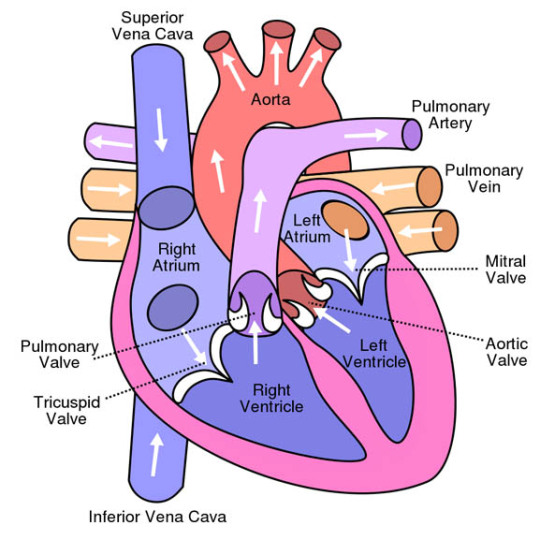
Human Respiratory System
Human the respiratory system helps our body exchange oxygen and carbon dioxide. We inhale oxygen through our nostrils which open into the nasal chamber through a nasal passage. Then the oxygen goes through pharynx, a common passage for both air and food. The air goes through trachea and then to the left and right bronchi. Each bronchus is divided into finer channels knows as bronchioles. The bronchioles lead to a vascular bag-like structure alveoli. The respiratory system also consists of a pair of a sac-like structure called lunges which are covered by a double-layered membrane known as pleura.
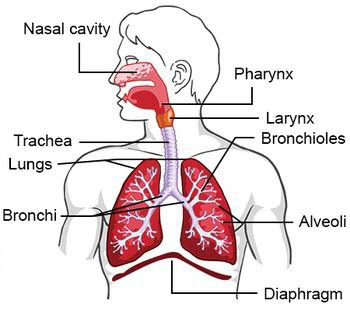
Nutrition is Amoeba
Amoeba is a unicellular organism that engulfs its food with the help of temporary figure-like projection of its body surface called pseudopodia and forms a food vacuole. The food is broken down inside the food vacuole and diffused into the cytoplasm. The undigested material is thrown out through the cell surface.
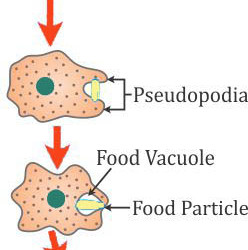
Human Male and Female Reproductive System
Male and the female reproductive system helps in the process of reproduction.
The male reproductive system consists of testicles, epididymis, Vas deferens, accessory glands, and penis.

The female reproductive system consists of a pair of ovaries, fallopian tube, uterus, cervix, and vagina.
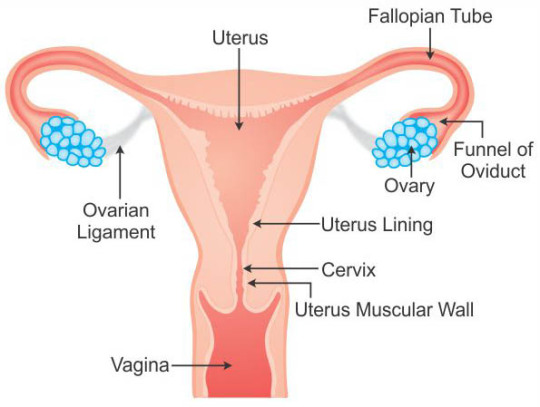
Budding in Yeast and Hydra
Budding is a method of reproduction in unicellular organisms. In this method, a bud-like projection is formed on the body of the parent organism. The bud develops as an individual and later separates from the parent and forms an independent individual.

Longitudinal section of a flower
A flower contains both male and female reproductive parts. Stamen, the male reproductive part of a flower consists of two subsections anther and filament. While, the female reproductive part known as pistil consists of three subsections stigma, style, and ovary.

The above given diagrams are important for the purpose of Board examination. Including diagrams to your answers would make it more informative. It is also easier to learn a complex concept with the help of a diagram. Students are advised to practice these diagrams as many times as possible before the examination. For more content regarding Board examination stay tuned to NTSEGuru.
#science#biology#Class 10#class x#class 10 science#class 10 biology#class 10 biology diagrams#class 10 exam#10th exam#exam#exam preparation#ntseguru#ntse guru
0 notes